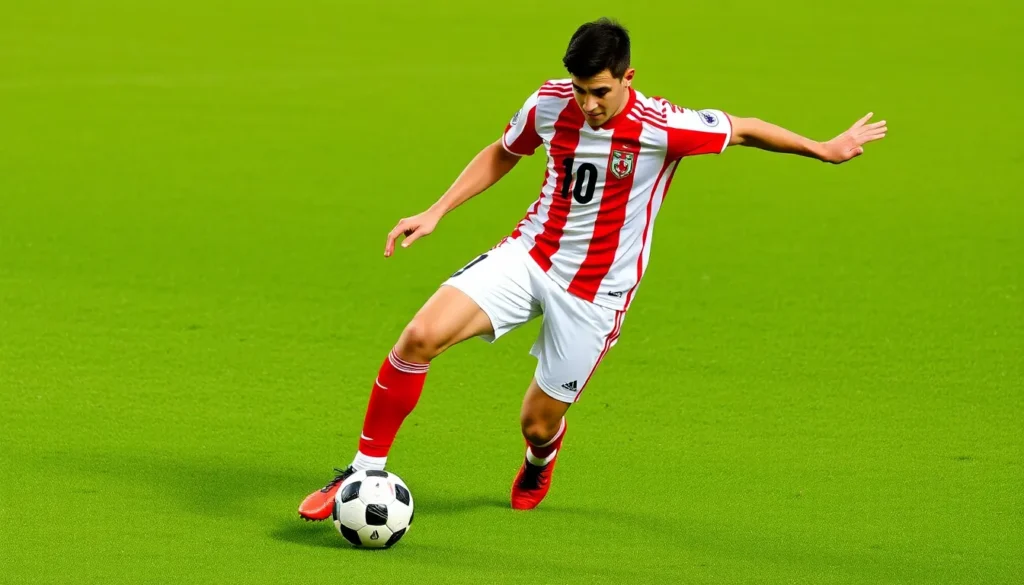In the thrilling world of football management, the inside forward is the secret weapon every manager dreams of. Picture a player who dances between defenders, unleashing creativity and chaos with every touch of the ball. This role isn’t just about scoring goals; it’s about turning the tide of a match and leaving opponents scratching their heads.
Table of Contents
ToggleUnderstanding the Inside Forward Role
Inside forwards occupy a dynamic position on the field, playing a crucial part in offensive tactics. Their versatile nature makes them essential, as they penetrate defenses and position themselves for goal-scoring opportunities.
Definition of an Inside Forward
An inside forward is a forward player typically positioned between the wingers and the center-forward. This role blends the responsibilities of attacking and creative play. Inside forwards often exploit spaces, cutting into central areas to assist in creating goal-scoring chances. Skillful dribbling and quick decision-making define their contributions, allowing for fluidity in attack. They frequently target defensive weaknesses, aiming to unbalance the opposition and create openings.
Historical Context in Football Manager
The inside forward role has evolved significantly throughout football history. Initially, teams utilized traditional formations like the WM shape in the 1920s, featuring inside forwards as key creators. The 1960s saw the rise of more fluid attacking styles, further integrating inside forwards into tactical variations. Managers began emphasizing their ability to offer options both centrally and out wide, enhancing team creativity. By the late 20th century, this role gained prominence, with notable players redefining its impact on the game. Football Manager reflects this evolution, allowing users to strategize with inside forwards effectively.
Key Attributes of an Inside Forward
Inside forwards possess specific attributes that enhance their effectiveness in the game. These skills contribute significantly to their ability to influence matches and create opportunities.
Essential Skills for Success
Dribbling technique stands out among essential skills for inside forwards. This skill allows players to maneuver past defenders with ease. Ball control remains crucial, enabling them to maintain possession under pressure. Vision plays an important role, providing the ability to spot teammates in advantageous positions. Finishing ability proves vital as well, leading to successful goal conversions. Finally, tactical awareness ensures they exploit spaces effectively within opposing defenses.
Ideal Player Characteristics
Agility represents a key characteristic of effective inside forwards. This trait enhances their ability to change direction swiftly and evade tackles. Speed provides an additional advantage, allowing players to break away and create goal-scoring opportunities. Technical proficiency in passing and shooting adds depth to their game, making them more versatile. Finally, a strong work ethic drives inside forwards to track back defensively when necessary, demonstrating commitment to team play.
Strategies for Utilizing Inside Forwards
Inside forwards play a crucial role in modern football, and their utilization often defines a team’s attacking capabilities. Managers can apply specific strategies to maximize their impact on the game.
Tactical Systems That Favor Inside Forwards
In a 4-3-3 formation, inside forwards effectively exploit defensive gaps. This setup allows them to drift inside, engaging defenders and creating space for wingers. Additionally, a 4-2-3-1 formation enhances their ability to link up with the central attacking midfielder, fostering creativity in the final third. Another effective system involves the 3-5-2, where inside forwards can leverage width from wing-backs while maintaining goal-scoring opportunities. Overall, defensive lines are stretched, creating chances that increase the likelihood of scoring.
Role in Different Formations
Various formations highlight the inside forward’s adaptability. In a classic 4-4-2 setup, they often play as second strikers, assisting the primary forward while providing width. Alternatively, in a modern 4-2-4 formation, inside forwards possess the freedom to interchange positions fluidly with wingers. This rotation keeps defenders guessing and can disrupt organizational structures. Consequently, their presence ensures constant pressure against the opponent’s defensive line, resulting in higher goal-scoring chances. Managers often find this versatility invaluable in changing match dynamics.
Tips for Scouting and Training Inside Forwards
Scouting and training inside forwards requires a keen eye for talent and effective development techniques.
Identifying Potential Talent
Seek players who exhibit strong dribbling skills and exceptional ball control. Look for individuals with a natural tendency to exploit defensive gaps. Evaluate their vision during games, as awareness of teammates and opponents significantly influences their effectiveness. Focus on players who consistently make intelligent runs and create goal-scoring opportunities. Prioritize young talents who demonstrate agility and speed, as these traits are crucial for success in this position. Assess their finishing ability through performance metrics, including shot accuracy and goals scored in various competitions.
Training Regimens for Development
Implement training sessions that emphasize technical skills, including passing and shooting drills. Incorporate agility drills to enhance speed and maneuverability on the field. Focus on situational exercises that simulate match conditions, allowing players to practice decision-making under pressure. Establish routines that encourage tactical awareness, incorporating team strategies and positioning drills. Regularly review video footage with players to identify areas for improvement. Emphasize the importance of fitness and conditioning, as endurance plays a vital role in maintaining peak performance throughout matches.
The inside forward position remains a game-changer in football management. Its unique blend of creativity and attacking prowess allows teams to unlock defenses and create scoring opportunities. Managers who effectively utilize inside forwards can significantly enhance their team’s offensive strategy, making it essential to scout and develop players with the right attributes.
As football continues to evolve, the role of the inside forward will likely adapt further, emphasizing the need for versatility and tactical awareness. By focusing on training and conditioning, teams can maximize the potential of these players, ensuring they remain a vital component in modern football tactics. Embracing the inside forward’s capabilities can lead to a more dynamic and successful approach on the pitch.









